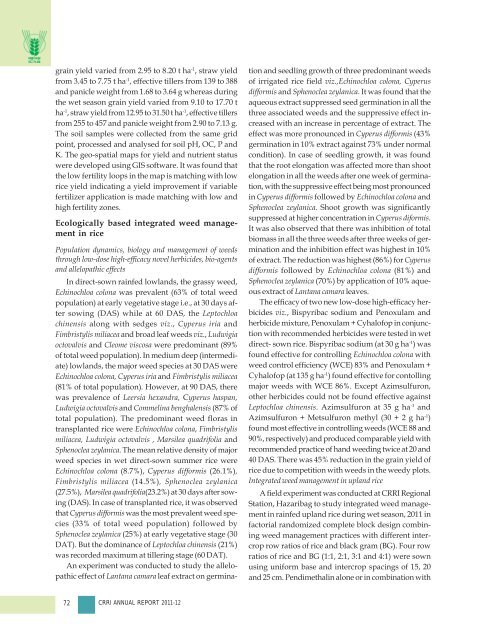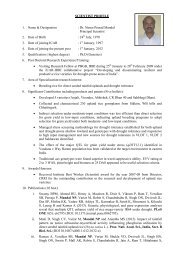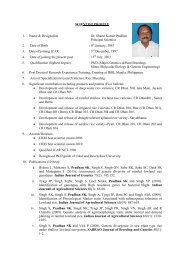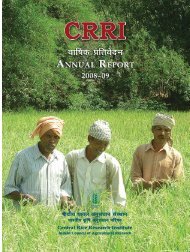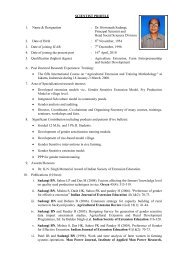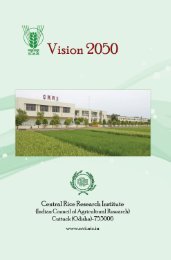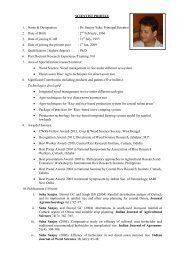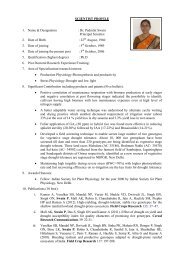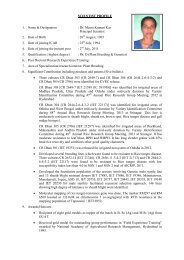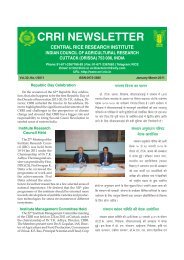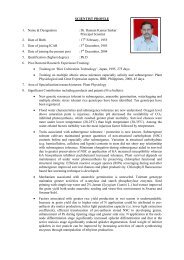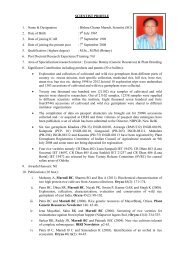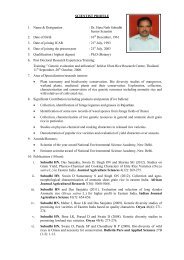Central Rice Research Institute Annual report...2011-12
Central Rice Research Institute Annual report...2011-12
Central Rice Research Institute Annual report...2011-12
Create successful ePaper yourself
Turn your PDF publications into a flip-book with our unique Google optimized e-Paper software.
grain yield varied from 2.95 to 8.20 t ha -1 , straw yield<br />
from 3.45 to 7.75 t ha -1 , effective tillers from 139 to 388<br />
and panicle weight from 1.68 to 3.64 g whereas during<br />
the wet season grain yield varied from 9.10 to 17.70 t<br />
ha -1 , straw yield from <strong>12</strong>.95 to 31.50 t ha -1 , effective tillers<br />
from 255 to 457 and panicle weight from 2.90 to 7.13 g.<br />
The soil samples were collected from the same grid<br />
point, processed and analysed for soil pH, OC, P and<br />
K. The geo-spatial maps for yield and nutrient status<br />
were developed using GIS software. It was found that<br />
the low fertility loops in the map is matching with low<br />
rice yield indicating a yield improvement if variable<br />
fertilizer application is made matching with low and<br />
high fertility zones.<br />
Ecologically based integrated weed management<br />
in rice<br />
Population dynamics, biology and management of weeds<br />
through low-dose high-efficacy novel herbicides, bio-agents<br />
and allelopathic effects<br />
In direct-sown rainfed lowlands, the grassy weed,<br />
Echinochloa colona was prevalent (63% of total weed<br />
population) at early vegetative stage i.e., at 30 days after<br />
sowing (DAS) while at 60 DAS, the Leptochloa<br />
chinensis along with sedges viz., Cyperus iria and<br />
Fimbristylis miliacea and broad leaf weeds viz., Ludwigia<br />
octovalvis and Cleome viscosa were predominant (89%<br />
of total weed population). In medium deep (intermediate)<br />
lowlands, the major weed species at 30 DAS were<br />
Echinochloa colona, Cyperus iria and Fimbristylis miliacea<br />
(81% of total population). However, at 90 DAS, there<br />
was prevalence of Leersia hexandra, Cyperus haspan,<br />
Ludwigia octovalvis and Commelina benghalensis (87% of<br />
total population). The predominant weed floras in<br />
transplanted rice were Echinochloa colona, Fimbristylis<br />
miliacea, Ludwigia octovalvis , Marsilea quadrifolia and<br />
Sphenoclea zeylanica. The mean relative density of major<br />
weed species in wet direct-sown summer rice were<br />
Echinochloa colona (8.7%), Cyperus difformis (26.1%),<br />
Fimbristylis miliacea (14.5%), Sphenoclea zeylanica<br />
(27.5%), Marsilea quadrifolia(23.2%) at 30 days after sowing<br />
(DAS). In case of transplanted rice, it was observed<br />
that Cyperus difformis was the most prevalent weed species<br />
(33% of total weed population) followed by<br />
Sphenoclea zeylanica (25%) at early vegetative stage (30<br />
DAT). But the dominance of Leptochloa chinensis (21%)<br />
was recorded maximum at tillering stage (60 DAT).<br />
An experiment was conducted to study the allelopathic<br />
effect of Lantana camara leaf extract on germination<br />
and seedling growth of three predominant weeds<br />
of irrigated rice field viz.,Echinochloa colona, Cyperus<br />
difformis and Sphenoclea zeylanica. It was found that the<br />
aqueous extract suppressed seed germination in all the<br />
three associated weeds and the suppressive effect increased<br />
with an increase in percentage of extract. The<br />
effect was more pronounced in Cyperus difformis (43%<br />
germination in 10% extract against 73% under normal<br />
condition). In case of seedling growth, it was found<br />
that the root elongation was affected more than shoot<br />
elongation in all the weeds after one week of germination,<br />
with the suppressive effect being most pronounced<br />
in Cyperus difformis followed by Echinochloa colona and<br />
Sphenoclea zeylanica. Shoot growth was significantly<br />
suppressed at higher concentration in Cyperus diformis.<br />
It was also observed that there was inhibition of total<br />
biomass in all the three weeds after three weeks of germination<br />
and the inhibition effect was highest in 10%<br />
of extract. The reduction was highest (86%) for Cyperus<br />
difformis followed by Echinochloa colona (81%) and<br />
Sphenoclea zeylanica (70%) by application of 10% aqueous<br />
extract of Lantana camara leaves.<br />
The efficacy of two new low-dose high-efficacy herbicides<br />
viz., Bispyribac sodium and Penoxulam and<br />
herbicide mixture, Penoxulam + Cyhalofop in conjunction<br />
with recommended herbicides were tested in wet<br />
direct- sown rice. Bispyribac sodium (at 30 g ha -1 ) was<br />
found effective for controlling Echinochloa colona with<br />
weed control efficiency (WCE) 83% and Penoxulam +<br />
Cyhalofop (at 135 g ha -1 ) found effective for contolling<br />
major weeds with WCE 86%. Except Azimsulfuron,<br />
other herbicides could not be found effective against<br />
Leptochloa chinensis. Azimsulfuron at 35 g ha -1 and<br />
Azimsulfuron + Metsulfuron methyl (30 + 2 g ha -1 )<br />
found most effective in controlling weeds (WCE 88 and<br />
90%, respectively) and produced comparable yield with<br />
recommended practice of hand weeding twice at 20 and<br />
40 DAS. There was 45% reduction in the grain yield of<br />
rice due to competition with weeds in the weedy plots.<br />
Integrated weed management in upland rice<br />
A field experiment was conducted at CRRI Regional<br />
Station, Hazaribag to study integrated weed management<br />
in rainfed upland rice during wet season, 2011 in<br />
factorial randomized complete block design combining<br />
weed management practices with different intercrop<br />
row ratios of rice and black gram (BG). Four row<br />
ratios of rice and BG (1:1, 2:1, 3:1 and 4:1) were sown<br />
using uniform base and intercrop spacings of 15, 20<br />
and 25 cm. Pendimethalin alone or in combination with<br />
72 CRRI ANNUAL REPORT 2011-<strong>12</strong>


